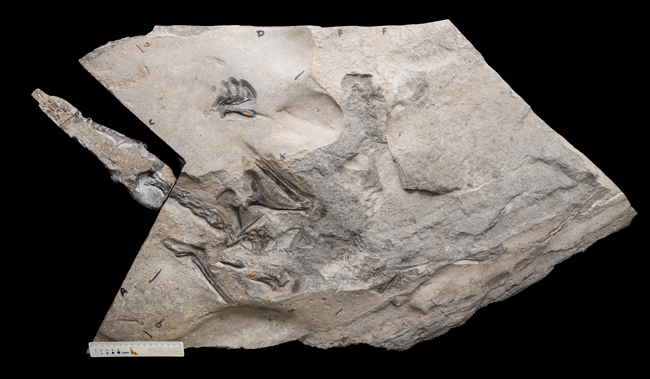Fantastic Pterosaur Fossil from the Isle of Skye
Around 170 million years ago, a toothy terror soared over the mudflats close to a tropical sea. Today, this land is the Isle of Skye and a team of researchers have published details of the remarkably well-preserved remains of that flying reptile. The fossil material found in Lealt Shale Formation exposures on the rocky coastline at Brothers’ Point (Rubha nam Brathairean), represents the most complete skeleton of a Middle Jurassic pterosaur ever found in the UK. With an estimated wingspan of 2.5 metres Dearc sgiathanach was a giant for this time in the Mesozoic.
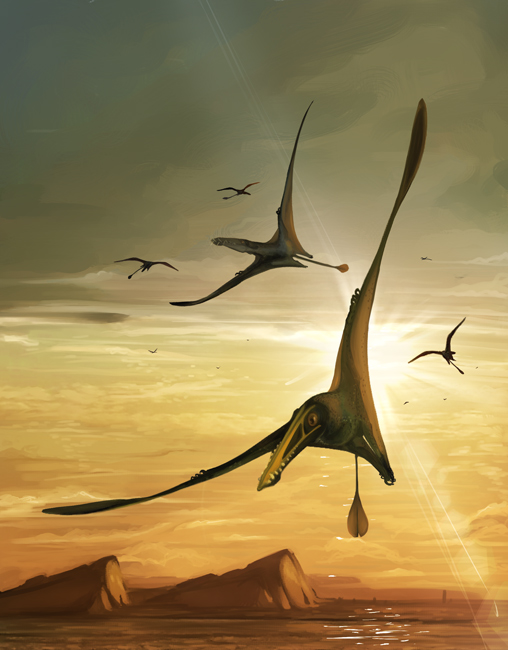
Dominating the skies on the Isle of Skye. Several pterosaurs flying over the coastline (Dearc sgiathanach). Picture credit: Natalia Jagielska.
Picture credit: Natalia Jagielska
A Spectacular Pterosaur Fossil
Pterosaurs were the first vertebrates to evolve powered flight. Their evolutionary origins remain obscure. In comparison to the Dinosauria, their light, hollow bones have a poor fossil preservation potential. Very little is known about pterosaur evolution in the Early and Middle Jurassic, due to a global lack of fossils. The Middle Jurassic strata on the Isle of Skye are regarded as hugely important due to the number of vertebrate fossils preserved therein and the island has recently been awarded greater protection from the Scottish Government: Legal Protection for Isle of Skye Fossil Sites.
The spectacular specimen, discovered by PhD student Amelia Penny (University of Edinburgh), in 2017 during a field trip led by Professor Steve Brusatte (Personal Chair of Palaeontology and Evolution, School of GeoSciences, University of Edinburgh), is now part of the National Museums Scotland vertebrate fossil collection.
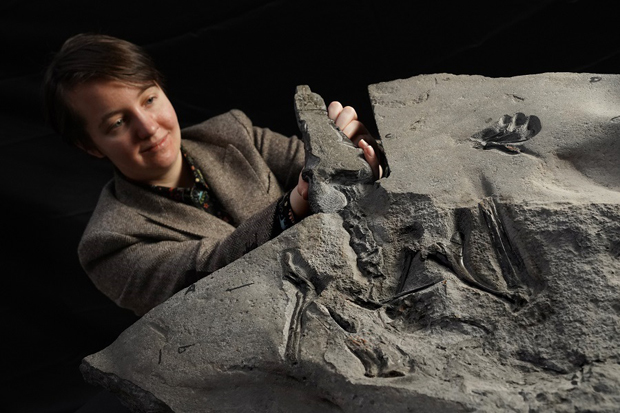
PhD student Natalia Jagielska unveils the 170 million year old pterosaur fossil: Picture credit: Stewart Attwood.
Picture credit: Stewart Attwood
A Gaelic Name for a Scottish Pterosaur
The new species has been named Dearc sgiathanach (pronounced jark ski-an-ach). It translates as “winged reptile”. The species name also references the Gaelic term for the Isle of Skye (An t-Eilean Sgitheanach), in Gaelic, the Isle of Skye is known as the “winged isle”. A phylogenetic assessment of D. sgiathanach places it within the long-tailed pterosaur family the Rhamphorhynchidae. Comparing bones from specimens of Rhamphorhynchus and the related rhamphorhynchid Dorygnathus, permitted the research team to estimate that Dearc sgiathanach probably had a wingspan of around 2.5 metres when fully grown.
Bone histology using a wing finger bone from the Isle of Skye specimen indicates that this individual was over two years old when it died, but it was still actively growing and it had not reached adult size.
Picture credit: Gregory Funston
Commenting on the estimated size of Dearc sgiathanach Steve Brusatte stated:
“Dearc is the biggest pterosaur we know from the Jurassic period and that tells us that pterosaurs got larger much earlier than we thought, long before the Cretaceous period when they were competing with birds, and that’s hugely significant.”
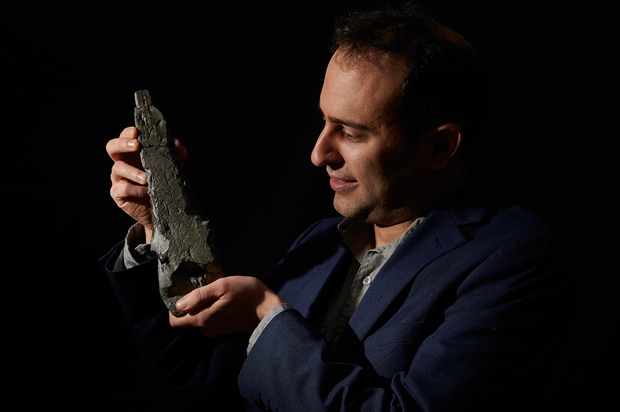
Professor Steve Brusatte holding the fossilised skull of Dearc sgiathanach. Picture credit: Stewart Attwood.
Picture credit: Callum Bennetts
A Battle Against the Incoming Tide
After Amelia Penny had alerted the rest of the field team about her discovery on the beach, a painstaking operation ensued to extract the fossil, led by Dugald Ross of Staffin Museum, involving the use of diamond-tipped saws to cut it from the rock, all while racing against time as the tide came in. The fossil had to be abandoned as the tide returned and its removal was only completed once the tide had begun to recede again.
Preparation of the beautifully preserved specimen was carried out by Nigel Larkin who is involved with the conservation of the Rutland ichthyosaur, the discovery of which was announced last month: The Giant Rutland Ichthyosaur.
Lead author of the paper, published in “Current Biology”, Natalia Jagielska stated:
“Dearc is a fantastic example of why palaeontology will never cease to be astounding. Pterosaurs preserved in such quality are exceedingly rare and are usually reserved to select rock formations in Brazil and China. And yet, an enormous superbly preserved pterosaur emerged from a tidal platform in Scotland.”
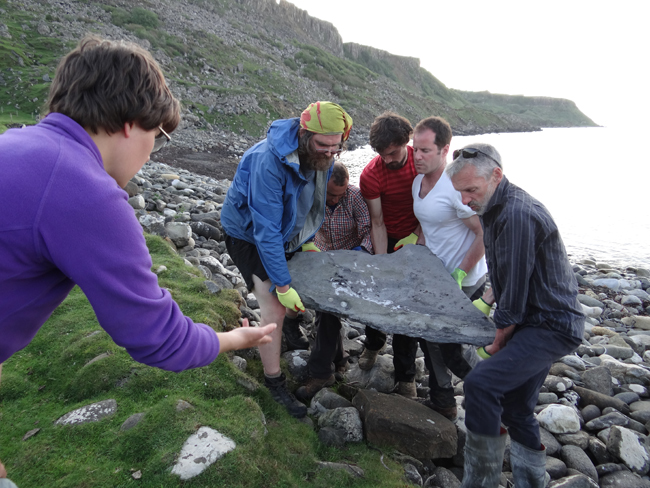
Removing the pterosaur fossil from the beach. Picture credit: Steve Brusatte/National Museums of Scotland.
Picture credit: Steve Brusatte/National Museums of Scotland
A Lot to Learn from the Pterosaur Fossil
CT scans of the skull revealed large optic lobes indicating that Dearc had excellent eyesight. The conical teeth in the jaws suggest that this pterosaur was a piscivore. The discovery of Dearc sgiathanach reveals that pterosaurs, during the Middle Jurassic were capable of reaching sizes comparable to the largest living, volant birds alive today. Fragmentary pterosaur fossils had previously indicated that flying reptiles with wingspans in excess of 1.8 metres in diameter were present in the Middle Jurassic and the Isle of Skye fossil provides definitive proof.
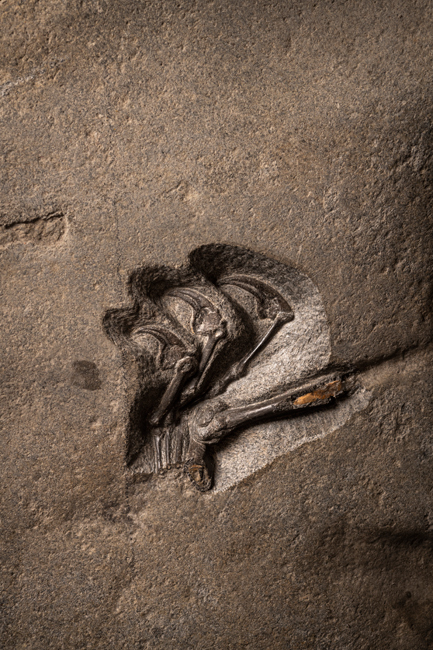
A close-up view of the claws on the foot of Dearc sgiathanach. The fossil was prepared by conservator Nigel Larkin. Picture credit: Gregory Funston.
Picture credit: Gregory Funston
Subject to Further Analysis
The four slabs that comprise the D. sgiathanach specimen will be the subject of further analysis and study by Natalia Jagielska. It promises to reveal important insights into the anatomy, phylogeny, aerial abilities, feeding habits and favoured habitats of Middle Jurassic pterosaurs.
The research team are confident that this remarkable fossil will help palaeontologists to gain a better understanding of the taxonomic relationships and evolution of Middle Jurassic members of the Pterosauria.
We can expect to hear more from Dearc sgiathanach in the near future.
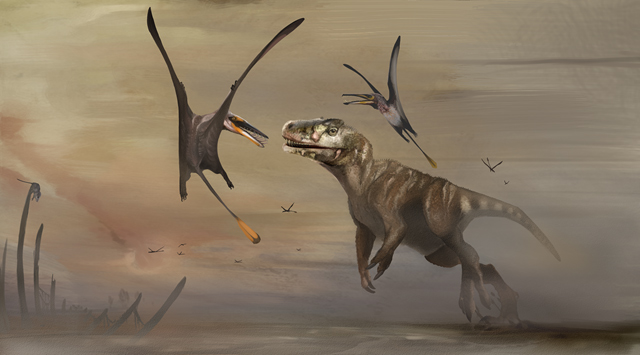
The Isle of Skye 170 million years ago. A theropod dinosaur hopes to catch a Dearc sgiathanach, but this large pterosaur is too quick and avoids capture. Picture credit: Natalia Jagielska.
Picture credit: Natalia Jagielska
Everything Dinosaur acknowledges the assistance of a media release from the University of Edinburgh in the compilation of this article.
The scientific paper: “A skeleton from the Middle Jurassic of Scotland illuminates an earlier origin of large pterosaurs” by Natalia Jagielska, Michael O’Sullivan, Gregory F. Funston, Ian B. Butler, Thomas J. Challands, Neil D. L. Clark, Nicholas C. Fraser, Amelia Penny, Dugald A. Ross, Mark Wilkinson and Stephen L. Brusatte published in Current Biology.
The Everything Dinosaur website: Dinosaur and Pterosaur Toys.


